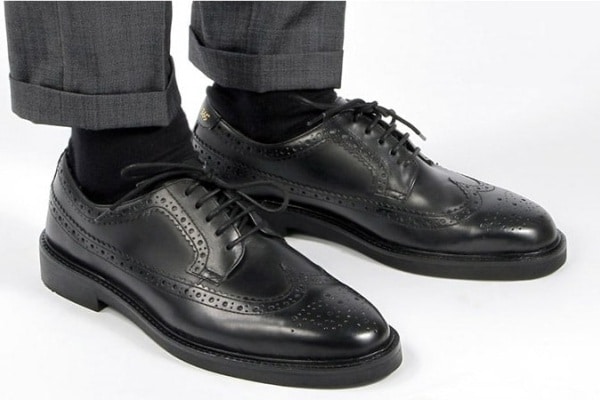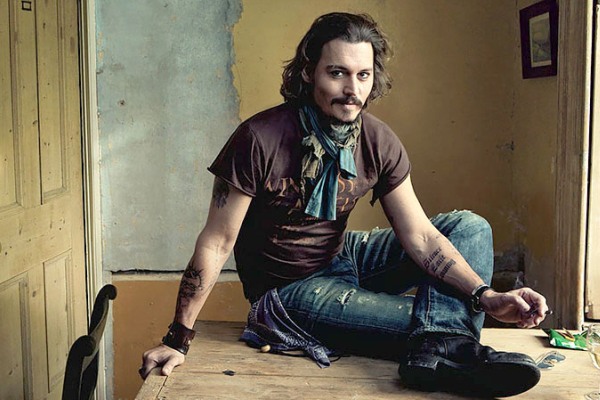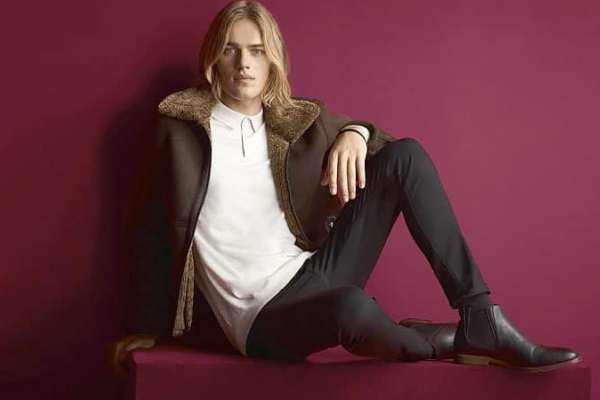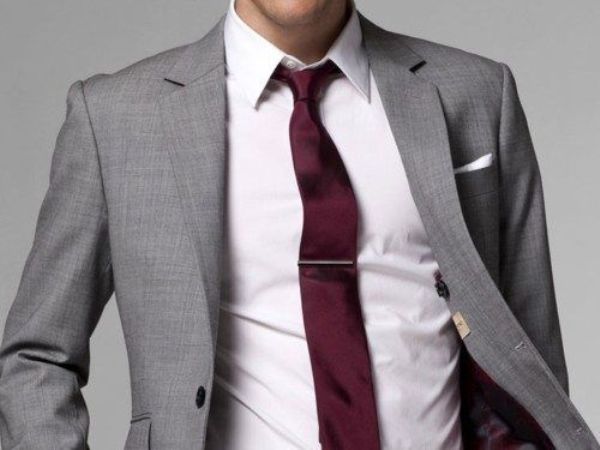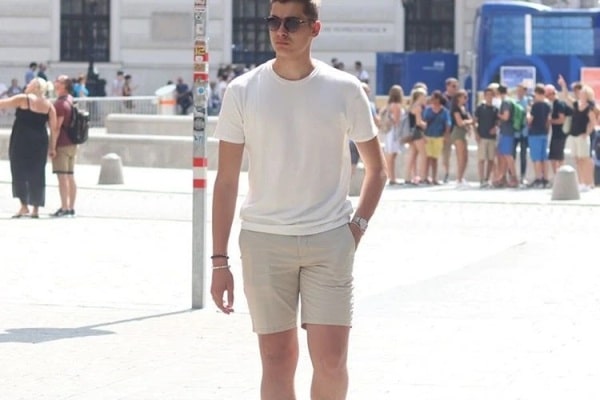How To Wear A Pea Coat For A Stylish Winter Look
How To Wear A Pea Coat For A Stylish Winter Look
Staple items for every man range from a great pair of jeans to sleek boots. Another piece every man should own is a classic pea coat. While the name may not sound very appealing, this overcoat has the power to dress up the simplest of outfits. For the ultimate go-to for this popular style, peruse our guide on how to wear a pea coat for a 101 on harnessing an old favorite.
What is Pea Coat?
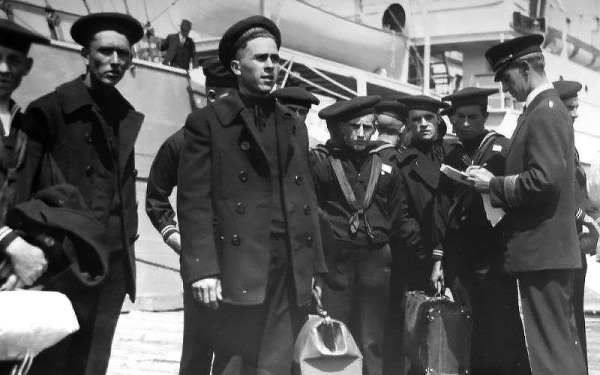
With its marine origins, a pea coat is defined as a short double-breasted overcoat that was typically made with heavy melton cloth. It traditionally features large-notch lapels and has bigger buttons on the front of the jacket. A beloved staple of autumn and winter, it was historically worn by sailors. Structured and masculine, this type of coat tends to amplify a simple sweater and jeans/chino combination. This coat is identifiable not only for its stylistic worth but also for its functionality – this is a utility piece that will warm you up in the midst of the colder months and will afford lots of practicality.
RELATED: How to Wear The Varsity Jackets With Style
The Peacoat Centuries Of Style
Like so much of the best outerwear for men, the peacoat is a decorated military veteran. It was invented by the Camplin family to supply the British Royal Navy. It was originally the uniform of the petty officer, but following World War II, surplus jackets found their way into the average man’s wardrobe. The style was embraced thanks to its timeless styling and practicality.
There is an ongoing debate among menswear buffs about the exact origins of the name. While some say it’s an abbreviation of ‘petty officers coat’, others believe it derives from the Dutch word ‘pijjekker‘, which describes a naval jacket that dates back to the 16th century.
To complicate things further, the word ‘Reefer’ came into use after the American Navy also began using the style. The term referred to the sailors who would climb a ship’s rigging, protected from the elements by their trusty coats. Whatever alias it goes by, it’s essentially the same good-looking garment.
Though the overall construction of the peacoat remains unaltered to this day; a handful of its original finishing touches are steered away from in today’s civilian designs. The buttons, for example, once comprised of six-to-eight brass fastenings, now more commonly made from rigid plastic or horn. The term ‘top brass’ [which refers to someone in a high position] comes from the brass-buttoned reefer jacket, as it was worn only by officers above decks and not by seamen below decks.
Other details commonly found on the original peacoat considered overboard in the modern-day include a rope-like ‘cordage’ connecting the top two buttons, which are more likely to earn seamen and poop-deck jokes than style points in the pub.
The Different Styles Of Peacoat
The Classic Peacoat
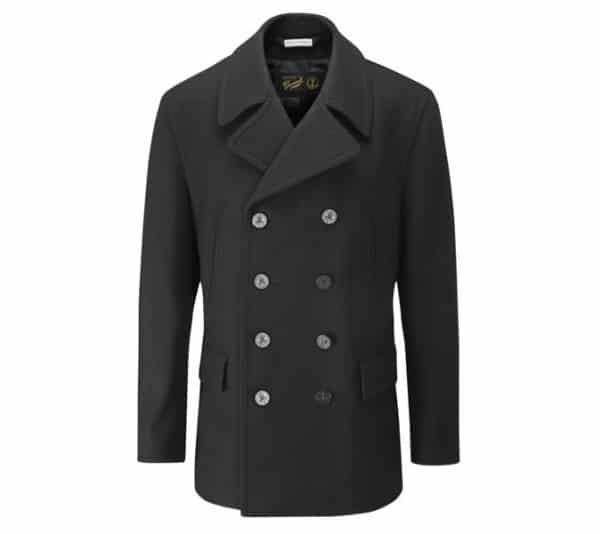
The most common style of peacoat features a cropped, double-breasted cut that flairs slightly at the hips.
This gives the wearer room to move, whether that’s climbing some rigging or just maneuvering your way to the bar. The large collar designed to keep the wind off your neck and usually features a notch lapel. But occasionally you’ll see a shawl version that gives a looser shape around the shoulders.
The Bridge Coat
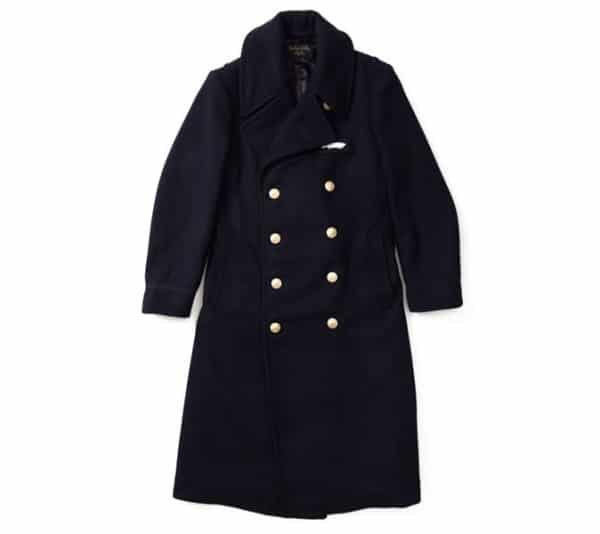
Originally designed for officers stationed on the bridge of a ship, the key difference here is the length. The large collar and double-breasted cut remain intact, but the coat reaches thigh- or even knee-length, crossing over slightly with an overcoat. This also one of the few versions where brass buttons sometimes still used; lending it to more dressed-up looks.
The Single-Breasted Peacoat
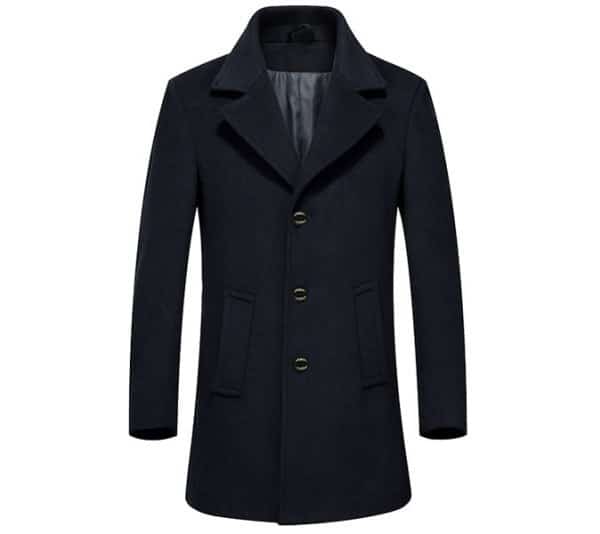
Although the classic peacoat comes double-breasted, there are examples (both current and historical) without overlapping flaps and just a single row of buttons. This style is slightly more casual, sharing elements with some styles of worker jackets.
How to Wear a Pea Coat
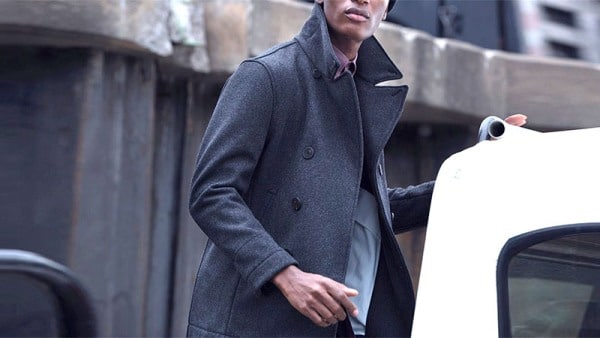
Pea coats are quite versatile. They can be worn with corporate wear, dressed up or down with your casual weekend looks. Regardless of how you style this item, the most important thing to remember is the shape and quality. You will want to invest in a pea coat that will fit well and won’t ruin after a few wears. When styling this item, leave the bottom button undone as you would with a blazer – this allows for a better hang when you are walking.
Black Pea Coat
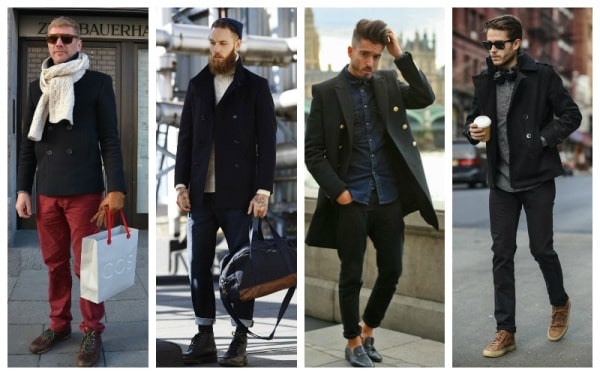
Black is considered the ultimate shade, but at times it can work to hinder color combinations. When styling a dark-colored pea coat for casual days, team it with other classic colors like reds and whites for a simple, yet more dimensional approach. A chino in a different tone can work well with black and also add textured scarves and denim pieces for a bit of distinction among this dark shade. Don’t look past a simple sweater to wear under your coat for relaxed, casual days. A black pea coat is also a worthy option for corporate wear, particularly when paired with a grey suit.
Grey Pea Coat
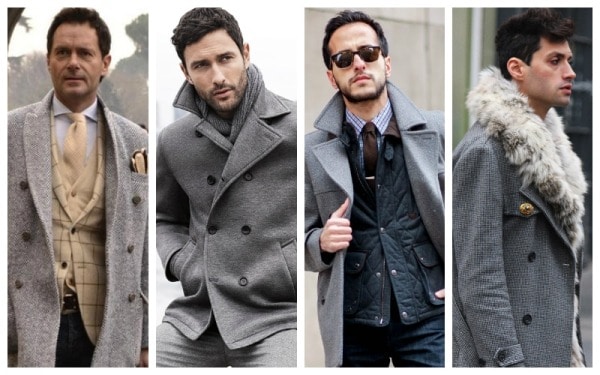
Grey pea coats can be a nice change from traditional black. Think strategically about what colors you will want to team it with. White is the ultimate shade to complement a lighter-tone grey pea coat. Charcoal grays can be teamed with other traditional colors like navies, burgundies, and emerald greens.
Navy Pea Coat
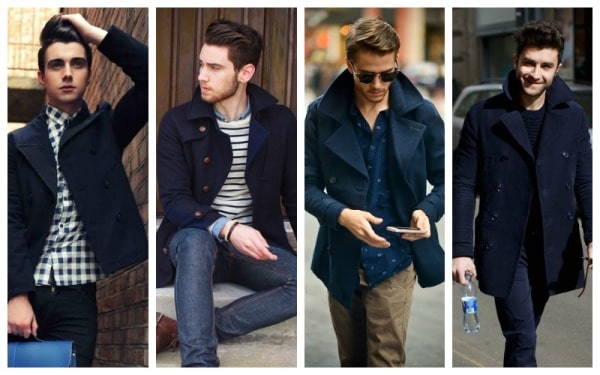
Navy is the ultimate color choice for practically anything, and pea coats are no exception. Teamed with blue jeans or chinos in various colors, a navy pea coat works particularly well for casual days. Turtlenecks or cable knit sweaters are great underneath and will read preppy yet still understated.
Green Pea Coat
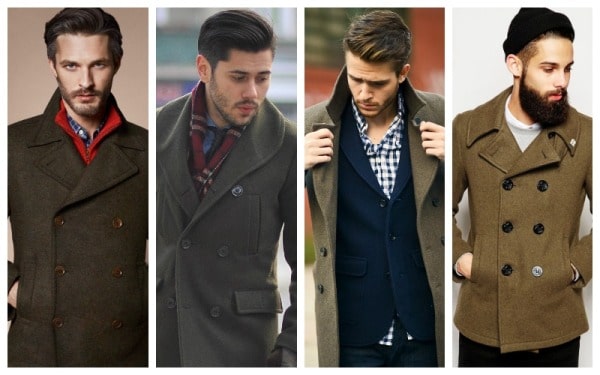
We would have guessed that green was the traditional color of choice for a pea coat. While this is not the case (navy the historically favored color), green a worthy alternative. Emerald, forest, and khaki greens are the three shades you should be searching for when trying to find the perfect green pea coat. These shades of green are the most versatile and can complement a broad range of richer, classic tones (think rich burgundy, deep navy, dusty brown, and dark wine). Green also works favorably with black, so don’t be afraid to pair a green pea coat with black denim jeans and a black t-shirt combination or with a standard black suit.
RELATED: How To Wear Brown In Stylish Ways
Camel Pea Coat

The ultimate for gents who favor predominantly neutral clothing, camel is classic and brings warmth to your existing pieces. Team your camel pea coat with beige, khaki, and wines for a traditional interpretation of the trend. Camel can also work well with blacks, which will register as modern and youthful; particularly if your tailoring is done correctly. Also, be sure to annotate looks that incorporate camel pea coats with novel accessories to boost the appeal of your coat.
Brown Pea Coat
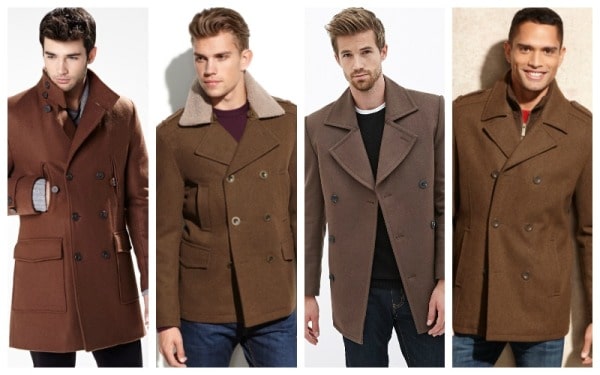
In the same color family as a camel, a rusty brown is also a great color alternative to a pea coat. A rich, deep brown is one of the most favorable tones to work with because it goes with almost everything. If you are a fan of the navy, a rich brown pea coat will be a more worthy investment than black. The trick to pulling off a brown pea coat is to ensure that the tailoring is just right – a younger, more modern silhouette will ensure that it reads stylish as opposed to outdated.
Long Pea Coat
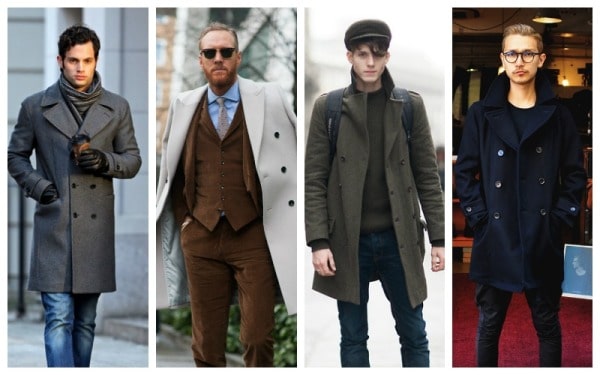
While not many of us would rock a long pea coat on a daily basis, there is most certainly a time and a place. Utilizing a longer pea coat with your corporate wear can be a great way to keep warm, but also to add a bit more color and dimension to a usual suit. Slung over your shoulders is another way to rock a longer pea coat, and it will read more relaxed yet still put together.
How a Pea Coat Should Fit
The peacoat designed for warmth, so it’s a close-fitting coat that has the added benefit of a flattering shape. From the high, wide collar, it should naturally taper to your waist before flaring out slightly at the hips. A traditional style should sit just below the hip to allow for easy movement.
That said, as with most types of outerwear, it’s a good idea to try one a size larger than normal – especially if you plan to wear your coat over chunky knitwear or multiple layers.
When doing it up, remember to keep the bottom button unfastened like you would a double-breasted blazer. And on cold days, leave your scarf behind and pop the generous collar for a Redford-approved way to look great in the winter.
The Best Peacoat Brands
Saint James
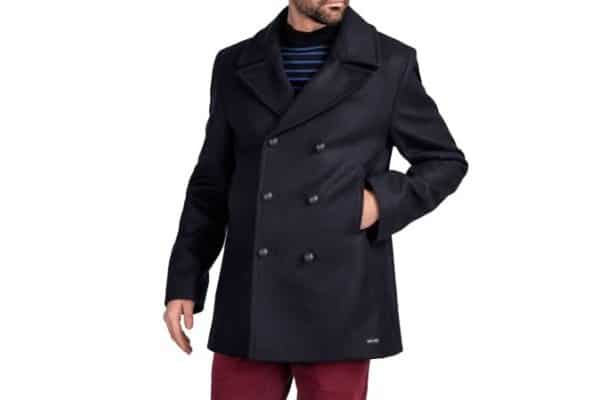
In 1160, William the Conqueror established the village of Saint-James on the Mont Saint-Michel bay in France. The sheep farmed in the local salt marshes provided the ideal strain of wool for knitting nautical gear to keep the local sailors and fishermen warm. Fast forward to today and still proudly made in France, the brand produces some of the finest and most authentic peacoats around.
Lands’ End
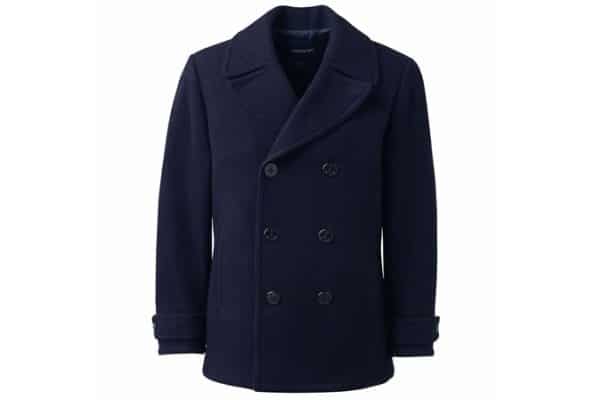
Founded as a mail-order business in Chicago during the 1960s, Lands’ End initially specialized in yachting gear. Inspired by the sea and the coast, it’s only natural the brand would eventually create a decent peacoat. Expect luxurious brushed wool and wool-blend options with welted hand-warmer pockets and lightweight PrimaLoft insulation for added ballast.
Reiss

Premium retailer Reiss well known and rightly regarded for its selection of smart coats. Built to last, using better quality wools than most others in its price range; everything from contemporary herringbone versions to classic weather-beating options; will slot seamlessly into any wardrobe.
Gloverall
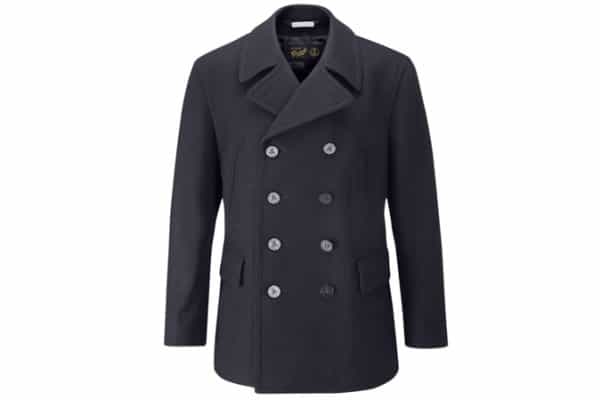
Steadfastly British; Gloverall’s heritage within outerwear stems from the 1950s when it sold thousands of surplus military coats after World War II. The brand’s ‘Churchill’ Reefer crafted from 100 percent English Melton wool and ready to fight on the seas; thanks to strong naval details including embossed buttons and an anchor motif.
Schott
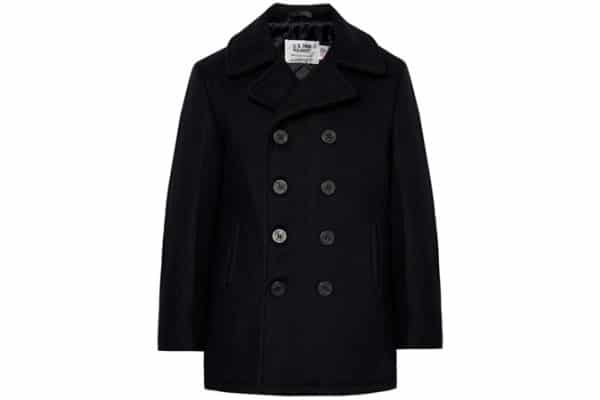
Marlon Brando’s outerwear label of choice; American specialist Schott uses the natural properties of wool as the starting point for its numerous peacoats. As well as being breathable; the fabric can also absorb 35 percent of its own weight in moisture without feeling wet; making it the perfect choice for the brand’s classically styled options.
London Tradition
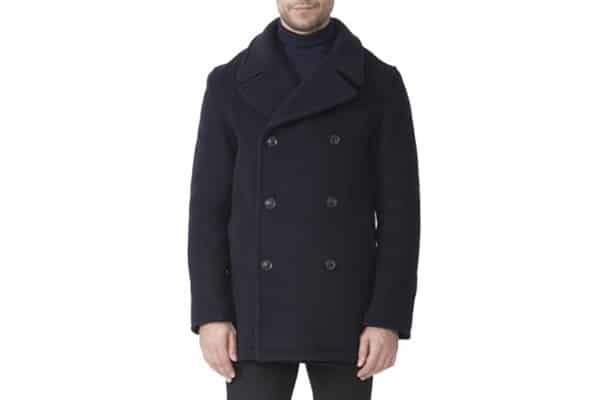
London Tradition may be a newcomer to the outerwear game. But the business founded in 2001 has already received a Queen’s Award for its lineup. Made in England, the brand’s peacoats add structured lapels and a rear vent to a quality wool construction; making it a great coat both on- and off-duty.
Private White V.C.

Private Jack White V.C. awarded the UK’s highest military honor during World War I. But that wasn’t his only achievement. He also founded a clothing factory in Manchester, England, which still thrives today; producing heritage menswear with a particularly good line of outerwear. The brand’s thick wool peacoat detailed with a shearling-trimmed collar for added warmth and a luxurious finish.

